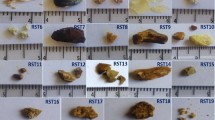Abstract
The central nuclei of 500 urinary calculi in Japan, including 421 calculi of upper urinary tracts, 64 calculi of lower urinary tracts and 15 prostatic calculi, were analysed by infrared spectroscopy. The results of analysis revealed that 50.8% of calculi were composed of mixed calcium oxalate-calcium phosphate; 17.4%, simple calcium oxalate; 17.4%, magnesium ammonium phosphate mixed with calcium phosphate, and probably also with calcium carbonate; 4.4%, uric acid and urate with or without calcium phosphate or calcium oxalate; 3.2%, calcium phosphate; 1.0%, cystine; and 0.2% (one case) were composed of protein.
Of 119 oxalate-phosphate calculi the ratios of calcium oxalate to calcium phosphate were measured on the chart of infrared spectra, and also the ratios of 53 cortices taken from these calculi were measured and compared to the ratios of these central nuclei. The results showed that the nuclei of oxalate-phosphate calculi contained greater amounts of calcium phosphate.
Résumé
Les noyaux centraux de 500 calculs urinaires, comportant 421 calculs des voies urinaires supérieures, 64 calculs des voies urinaires inférieures et 15 calculs de la prostate ont été analysés au Japon par spectroscopie infrarouge. Les résultats de cette analyse indiquent que 50,8% des calculs sont composés d'un mélange d'oxalate de calcium et phosphate de calcium: 17,4% d'oxalate de calcium simple; 17,4% de phosphate de magnésium ammoniaqué, mélangé au phosphate de calcium et probablement aussi au carbonate de calcium: 4,4% d'acide urique et d'urate avec ou sans phosphate de calcium ou d'oxalate de calcium: 3,2% de phosphate de calcium: 1,0% de cystine et 0,2% (un cas) constitué de protéine.
Sur 119 calculs, constitués d'oxalate-phosphate, les rapports de l'oxalate de calcium et du phosphate de calcium sont mesurés á l'aide des spectres infra-rouges et les rapports de 53 régions corticales de ces calculs ont été déterminés et comparés è ceux des régions nucléaires centrales. Il apparait ainsi que le noyau des calculs d'oxalate phosphate contient de plus grandes quantités de phosphate de calcium.
Zusammenfassung
In Japan wurden die zentralen Nuclei von 500 Nierensteinen mittels Infrarotspektroskopie untersucht. Es handelte sich dabei um 421 Steine aus den oberen Harnwegen, 64 Steine aus den unteren harnwegen und 15 Prostatasteine. Die Analysen ergaben folgende Resultate: 50,8% der Steine setzten sich aus einem Gemisch von Calciumoxalat und Calciumphosphat usammen; 17,4% enthielten nur Calciumoxalate; 17,4% bestanden aus einem Gemisch von Magnesiumammoniumphosphat mit Calciumphosphat und vermutlich auch Calciumcarbonat; 4,4% enthielten Harnsäure und Urate mit oder ohne Calciumphosphat oder Calciumoxalat; 3,2% bestanden aus Calciumphosphat; 1,0% aus Cystin und 0,2% (ein Fall) aus Protein.
Bei 119 Phosphatoxalatsteinen wurde das Verhältnis von Calciumoxalat zu Calciumphosphat aus den Kurven der erhaltenen Infrarotspektra bestimmt. Dieses Verhältnis wurde ebenfalls für die äußere Schicht von 53 solcher Steine berechnet und mit dem Wert der zugehörigen zentralen Nuclei verglichen. Aus diesen Resultaten geht hervor, daß die Nuclei der Phosphatoxalatsteine größere Mengen von Calciumphosphat enthalten.
Similar content being viewed by others
References
Beeler, M. F., Veith, D. A., Morriss, R. H., Biskind, G. R.: Analysis of urinary calculus. Amer. J. clin. Path.41, 553–560 (1964).
Beischer, D. E.: Analysis of renal calculi by infrared spectroscopy. J. Urol. (Baltimore)73, 653–659 (1955).
Chihara, G., Kurosawa, N., Takasaki, E.: Medical and biochemical application of infrared absorption spectra. II. Studies on urinary stone by infrared spectra. Chem. Pharm. Bull.7, 622–627 (1959).
Herring, L. C.: Observations on the analysis of ten thousand urinary calculi. J. Urol (Baltimore)88, 545–562 (1962).
Hodgkinson, A., Peacock, M., Nicholson, M.: Quantitative analysis of calcium-containing urinary calculi. Invest. Urol.6, 549–561 (1969).
Ichikawa, T., Kakizaki, T., Imamura, K., Takasaki, E., Chihara, G.: Urinary stone analysis by infrared spectrometry. I. Qualitative application. Jap. J. Urol.50, 1–21 (1959).
Klein, B., Seligson, H. T.: Identification of urinary tract calculi by infrared spectroscopy. Standard Methods of Clinical Chemistry4, 23–29 (1963).
Lenaghan, D.: Urinary calculi and their incidence in new australian migrants. Med. J. Aust.52 (ii), 65–73 (1965).
Lonsdale, K., Sutor, D. J., Wooley, S.: Composition of urinary calculi by x-ray diffraction. Collected data from various localities. Brit. J. Urol.40, 33–36 (1968).
Pollack, S. S., Carlson, G. L.: A comparison of x-ray diffraction and infrared technics for identifying kidney stones. Amer. J. clin. Path.52, 656–660 (1969).
Prien, E. L.: Crystallographic analysis of urinary calculi: A 23-year survey study. J. Urol. (Baltimore)89, 917–924 (1963).
Takasaki, E.: Urinary stone analysis by infrared spectrometry. II. Quantitative application. Jap. J. Urol.51, 639–663 (1960).
—, Shimano, E.: The urinary excretion of oxalic acid and magnesium in oxalate urolithiasis. Invest. Urol.5, 303–312 (1967).
Tsay, Y. C.: Application of infrared spectroscopy to analysis of urinary calculi. J. Urol. (Baltimore)86, 838–854 (1961).
Wax, S. H., Frank, I. N. A retrospective study of upper urinary tract calculi. J. Urol. (Baltimore)94, 28–32 (1965).
Weissman, M., Klein, B., Berkowitz, J.: Clinical applications of infrared spectroscopy. Analysis of renal tract calculi. Analyt. Chem.31, 1334–1338 (1959).
Author information
Authors and Affiliations
Rights and permissions
About this article
Cite this article
Takasaki, E. An observation on the analysis of urinary calculi by infrared spectroscopy. Calc. Tis Res. 7, 232–240 (1971). https://doi.org/10.1007/BF02062610
Received:
Accepted:
Issue Date:
DOI: https://doi.org/10.1007/BF02062610




